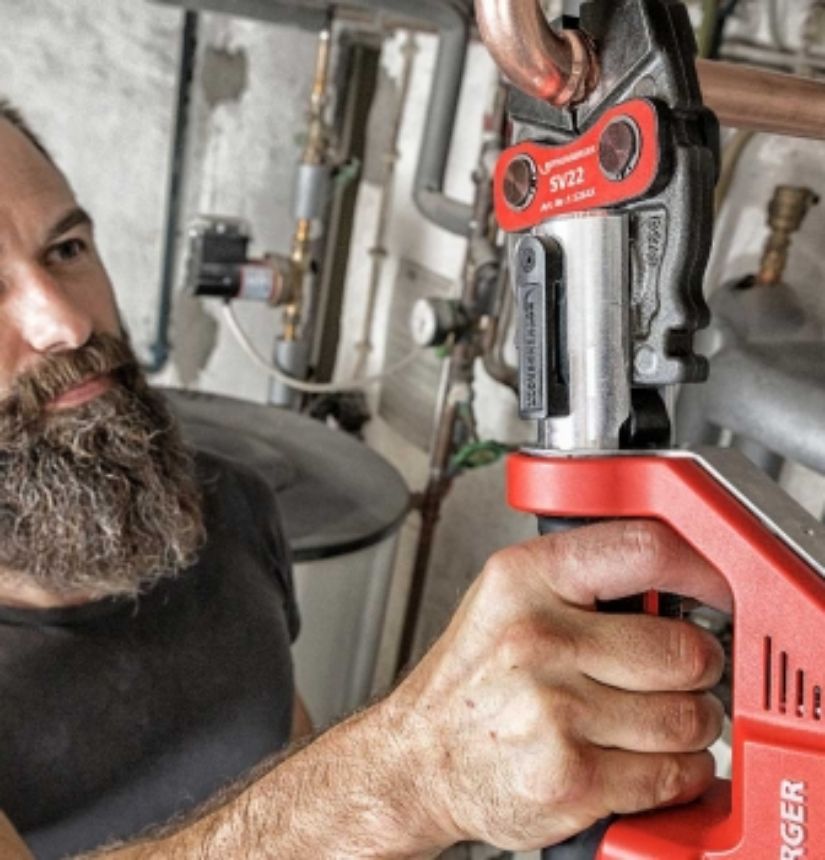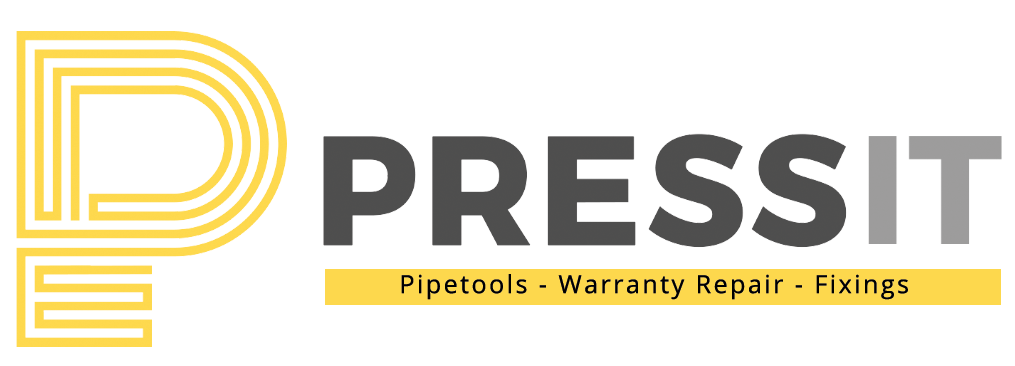
Understanding Press Tools
Press tools in the context of plumbing refer to specialised equipment used for making connections between pipes and fittings. These tools utilise a pressing mechanism to create secure and durable joints without the need for traditional methods like soldering or welding. The press tools typically consist of a press tool itself and compatible fittings that work in tandem. These fittings often have a specific design that allows them to be securely pressed onto pipes, forming a tight seal. The press tool exerts force on the fitting, deforming it slightly to create a reliable connection.
Benefits Of Press Tools
The advantages of press tools are significant, making them a preferred choice for many professionals. Here are some key benefits:
- Efficiency and Time-Saving: Press tools streamline the pipe connection process, significantly reducing the time required for plumbing projects. The efficiency of press tools allows plumbers to complete tasks swiftly, improving overall project timelines.
- Reduced Labor Costs: The ease of use and speed of press tools contribute to decreased labor costs. With quicker installations, plumbing professionals can take on more projects, maximizing their productivity and profitability.
- Consistent Connections: Press tools create uniform and reliable connections. The pressing mechanism ensures a tight and secure seal every time, minimizing the risk of leaks or other issues commonly associated with traditional methods like soldering.
- Versatility with Materials: Press tools are versatile and compatible with various plumbing materials, including copper, PEX, and stainless steel. This flexibility allows plumbers to use press tools across a wide range of projects, making them a versatile and cost-effective choice.
- Safety: Press tools often come with safety features, and when used correctly, they reduce the risks associated with open flames used in soldering. This contributes to a safer working environment for plumbing professionals.
- Environmental Impact: Compared to traditional methods like soldering, press tools have a lower environmental impact. They don’t involve the use of open flames or chemicals, making them a more environmentally friendly choice for plumbing installations.
- Ease of Use: Press tools are designed to be user-friendly, requiring minimal training for professionals to become proficient. The simplicity of operation enhances the accessibility of press tools for a wide range of plumbing applications.
- Adaptability to Tight Spaces: The compact design of press tools allows them to be used in confined or hard-to-reach spaces. This adaptability is particularly valuable in situations where traditional methods may be challenging to implement.
Other Tools and Equipment
several other tools and equipment complement the pressing process, ensuring smooth and efficient installations. Here’s a list of some essential tools used in conjunction with press tools if you are planning on starting to press:
- Press Jaws: These are the interchangeable components of the press tool that come in various sizes to accommodate different pipe diameters and fittings. Press jaws are crucial for creating a secure and proper connection.
- Pipe Cutter: Before using a press tool, a pipe cutter is often employed to precisely cut pipes to the required length. This ensures a clean and accurate fit when using press fittings.
- Deburring Tool: After cutting pipes, a deburring tool is used to remove any rough edges or burrs left on the pipe’s surface. This step is essential for achieving a smooth connection and preventing damage to the press fittings.
- Calibration Tools: Calibration tools are used to check and ensure the proper alignment and functioning of the press tool. Regular calibration is crucial for maintaining the tool’s accuracy and efficiency.
- Pipe Reaming Tool: In some cases, pipes may have sharp edges or imperfections that could affect the integrity of the press connection. A pipe reaming tool is used to remove these imperfections and create a smooth interior surface.
- Depth Gauge: To achieve consistent and accurate press connections, a depth gauge is used to measure the insertion depth of the pipe into the press fitting. This helps prevent under-pressing or over-pressing, ensuring a reliable seal.
- Adjustable Wrench: An adjustable wrench is handy for securing and stabilizing pipes during the pressing process. It provides additional support, especially when working in tight or awkward spaces.
- Battery or Power Source: Many press tools are powered either by batteries or an external power source. Ensuring a reliable and charged power supply is essential for the consistent operation of the press tool on-site.
- Carrying Case: A durable carrying case helps organize and protect press tools and accessories during transportation. It is essential for keeping the tools in good condition and readily accessible on the job.
- Pipe Marking Tools: Marking tools are used to indicate the correct placement of press fittings on pipes. Proper marking ensures precision during the pressing process, preventing errors in connection.
- Safety Gear: Personal protective equipment (PPE), including safety glasses and gloves, is crucial when working with press tools. Safety gear protects professionals from potential hazards associated with the plumbing work environment.
By using these tools in conjunction with press tools, plumbing professionals can ensure accurate, safe, and efficient installations, contributing to the overall success of plumbing projects.
New To Press?
As a newbie to press you are in safe hands with PressIT. We are warranty and 5 star service agents for all the popular plumbing press tool brands. Joining team #pressITuk you are guaranteed peace of mind and technical assistance when you need it. We have a dedicated page for people looking to start pressing, called ‘NEW TO PRESS’.
Navigating the realm of plumbing press tools isn’t without its challenges and misconceptions. Let’s delve into some common hurdles and misunderstandings associated with these innovative tools.
Challenges
- Initial Cost: One significant challenge is the upfront investment required for acquiring press tools. While they prove cost-effective in the long run, the initial expense might deter some plumbers or businesses with budget constraints.
- Training and Learning Curve: Transitioning to press tools demands training and familiarity. Some plumbers may face a learning curve when adapting to the new technology, potentially impacting initial efficiency until they become proficient.
- Compatibility Issues: Press tools are versatile, but not all fittings and pipes are compatible. Ensuring that the press tool aligns with the specific materials being used is crucial to avoid complications and potential leaks.
- Maintenance Requirements: Like any equipment, press tools require regular maintenance. Some plumbers may find it challenging to adhere to the recommended maintenance schedules, risking tool malfunctions and reduced lifespan.
- Tool Size and Accessibility: The size and design of press tools may pose challenges in tight or awkward spaces. Plumbers need to strategize and, at times, use additional tools to ensure accessibility in confined areas.
Common Misconceptions
- Not Suitable for All Materials: One common misconception is that press tools are limited in material compatibility. In reality, press tools are designed for various materials like copper, PEX, and stainless steel, offering versatility across different projects.
- Lack of Durability: Some may believe that press connections are less durable than traditional methods. However, when used correctly, press tools create reliable and robust connections, often exceeding the durability of soldered or welded joints.
- Complexity Equals Complication: The advanced technology of press tools might lead to the misconception that they are overly complex. In truth, manufacturers design these tools with user-friendliness in mind, ensuring that even with technological sophistication, they are easy to operate.
- Limited Application: Some plumbers may think press tools have a limited scope of application. Contrarily, press tools are versatile and can be used for a wide range of plumbing projects, from residential to commercial, and across various pipe sizes.
- Safety Concerns: There may be concerns about the safety of press tools, especially in comparison to traditional methods. In reality, press tools are designed with safety features, and with proper training, they provide a secure and reliable option for plumbing connections.
Understanding and addressing these challenges and misconceptions are vital for the successful integration of press tools into the plumbing industry. As technology advances, overcoming these hurdles will become increasingly manageable, further establishing press tools as a cornerstone of modern plumbing practices.
Conclusion
In conclusion, plumbing press tools have emerged as a transformative force in the plumbing industry, offering unparalleled efficiency, reliability, and versatility. Despite initial challenges such as cost and a learning curve, the benefits of press tools in terms of time-saving, reduced labor costs, and consistent connections outweigh the hurdles.
FAQs
- Are press tools suitable for all types of plumbing materials? Press tools are versatile and can be used with various materials like copper, PEX, and stainless steel.
- Do I need special training to use plumbing press tools? Yes, proper training and certification are essential for the safe and effective use of press tools.
- How do press tools compare to traditional soldering and welding methods? Press tools offer superior efficiency, reduced environmental impact, and consistent connections compared to traditional methods.
- Can press tools be used in DIY plumbing projects? While press tools simplify tasks, it’s recommended that they be used by trained professionals to ensure safety and quality.
- What is the expected lifespan of plumbing press tools? With proper maintenance, press tools can have a long lifespan, providing reliable service for many years.

not all pressfit jaws have the same profile and you should mention this fact and specify what jaws fit which profile and if any profiles are inter changeable